Period 1979 – 1990 | Location Nicaragua | |
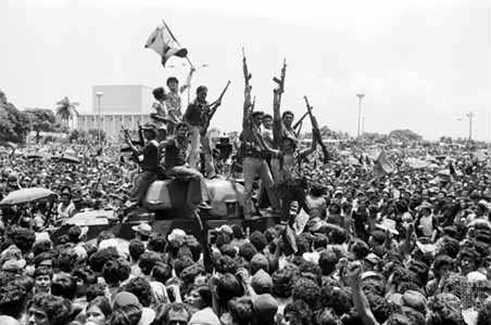 | ||
Combatants Similar Salvadoran Civil War, Cuban Revolution, United States occupatio, Bay of Pigs Invasion, Angolan Civil War | ||
The Nicaraguan Revolution (Spanish: Revolución Nicaragüense or Revolución Popular Sandinista) encompassed the rising opposition to the Somoza dictatorship in the 1960s and 1970s, the campaign led by the Sandinista National Liberation Front (FSLN) to violently oust the dictatorship in 1978–79, the subsequent efforts of the FSLN to govern Nicaragua from 1979 until 1990 and the Contra War which was waged between the FSLN and the Contras from 1981-1990.
Contents
- Background
- Rise of the FSLN
- Overthrow of the Somoza regime
- Sandinista regime
- Economic reforms
- Cultural Revolution
- Contra War
- 1984 general election
- Esquipulas
- UNO
- References
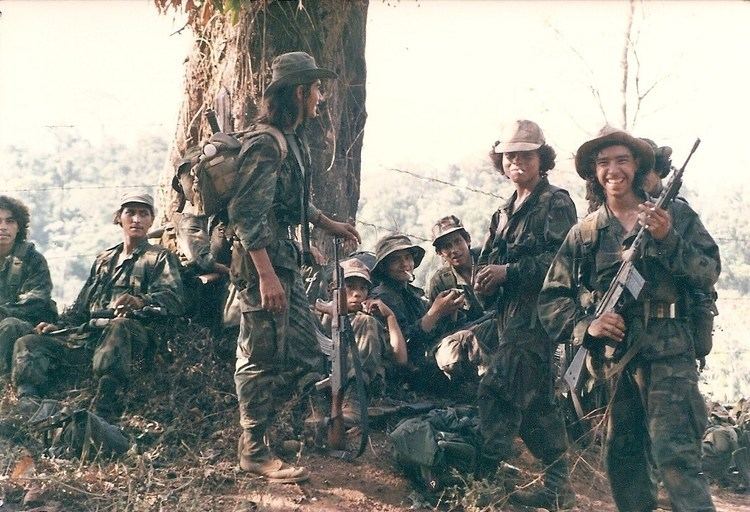
The Revolution marked a significant period in Nicaraguan history and revealed the country as one of the major proxy war battlegrounds of the Cold War with the events in the country rising to international attention.
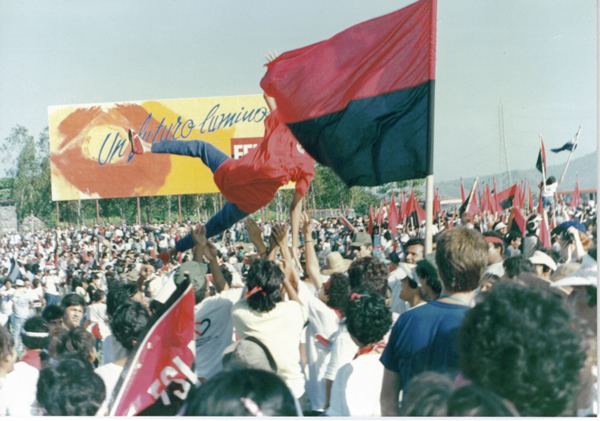
Although the initial overthrow of the Somoza regime in 1978–79 was a bloody affair, the Contra War of the 1980s took the lives of tens of thousands of Nicaraguans and was the subject of fierce international debate. During the 1980s both the FSLN (a leftist collection of political parties) and the Contras (a rightist collection of counter-revolutionary groups) received large amounts of aid from the Cold War super-powers (respectively, the Soviet Union and the United States).
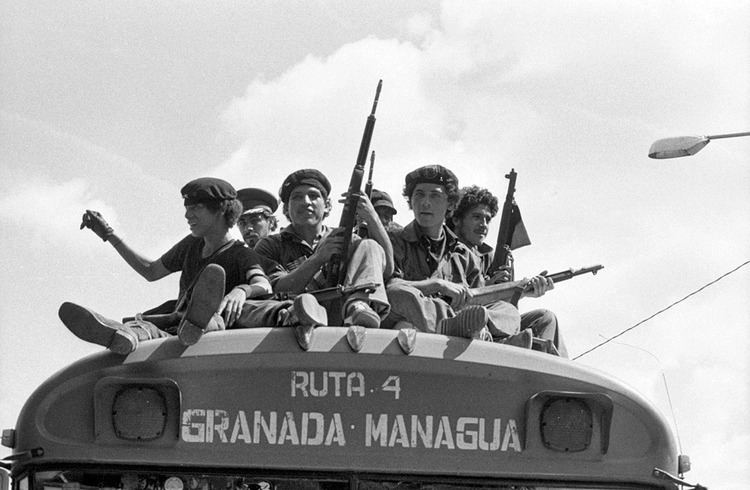
The Contra War ultimately ended following the signing of the Tela Accord in 1989 and the demobilization of the FSLN and Contra armies. A second election in 1990 resulted in the election of a majority of anti-Sandinista parties and the FSLN handing over power.
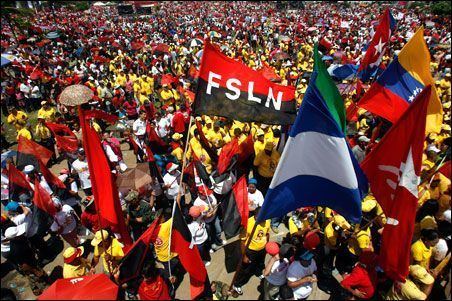
Background

Following the United States occupation of Nicaragua in 1912 during the Banana Wars, the Somoza family political dynasty came to power, and would rule Nicaragua until their ouster in 1979 during the Nicaraguan Revolution. The era of Somoza family rule was characterized by rising inequality and political corruption, strong US support for the government and its military, as well as a reliance on US-based multinational corporations.
Rise of the FSLN

In 1961 Carlos Fonseca Amador, Silvio Mayorga, and Tomás Borge Martínez formed the FSLN and, with the help of students, the organization gathered support from peasants and anti-Somoza elements within Nicaraguan society, as well as from the Communist Cuban government, the leftist Panamanian government of Omar Torrijos, and the Venezuelan government of Carlos Andrés Pérez. By the 1970s the coalition of students, farmers, businesses, churches, and a small percentage of Marxists was strong enough to launch a military effort against the regime of longtime dictator Anastasio Somoza Debayle.
Overthrow of the Somoza regime
In the 1970s the FSLN began a campaign of kidnappings which led to national recognition of the group in the Nicaraguan media and solidification of the group as a force in opposition to the Somoza Regime. The Somoza Regime, which included the Nicaraguan National Guard, a force highly trained by the U.S. military, used torture, extra-judicial killings, intimidation and censorship of the press in order to combat the FSLN attacks. This led to international condemnation of the regime and in 1978 the administration of U.S. president Jimmy Carter cut off aid to the Somoza regime due to its human rights violations (Boland Amendment).
On 10 January 1978 the editor of the leftist Managua newspaper La Prensa, Pedro Joaquín Chamorro Cardenal was murdered by suspected elements of the Somoza regime and riots broke out in the capital city, Managua, targeting the Somoza regime. Following the riots, a general strike on January 23–24 called for the end of the Somoza regime and was, according to the U.S. State Department staff at the U.S. Embassy, successful at shutting down around 80% of businesses in not only Managua but also the provincial capitals of Leon, Granada, Chinandega, and Matagalpa.
In the words of William Dewy, an employee of Citi Bank who witnessed the riots in Managua:
On 22 August 1978 the FSLN staged a massive kidnapping operation in which they took around 2,000 hostages at the National Palace in Managua. After two days, the government agreed to pay $500,000 and release certain prisoners resulting in a major victory for the FSLN.
In early 1979 the Organization of American States supervised negotiations between the FSLN and the government. However, these broke down when it became clear that the Somoza regime had no intention of allowing democratic elections to take place.
By June the FSLN controlled all of the country except the capital, and on 17 July 1979 President Somoza resigned and the FSLN entered Managua, giving full control of the government to the revolutionary movements.
Sandinista regime
Immediately following the fall of the Somoza regime, Nicaragua was largely in ruins. The country had suffered both war and, earlier, natural disaster in the form of the devastating 1972 Nicaragua earthquake. In 1979, approximately 600,000 Nicaraguans were homeless and 150,000 were either refugees or in exile out of a total population of just 2.8 million.
Economic reforms
The Revolution brought down the burden the Somocista regime had imposed upon the Nicaraguan economy and that had seriously deformed the country, creating a big and modern center, Managua, where Somoza's power had emanated to all corners of the territory, and then an almost semifeudalist rural economy with few productive goods, such as cotton, sugar and other tropical agricultural products. All sectors of the economy of Nicaragua were determined, in great part if not entirely, by the Somozas or the officials and adepts surrounding the regime, whether it was directly owning agricultural brands and trusts, or actively setting them to local or foreign hands. It is famously stated that Somoza himself owned 1/5 of all profitable land in Nicaragua. While this is not correct, Somoza or his adepts did own or give away banks, ports, communications, services and massive amounts of land.
The Nicaraguan Revolution brought immense restructuring and reforms to all three sectors of the economy, directing it towards a mixed economy system. The biggest economic impact was on the primary sector, agriculture, in the form of the Agrarian Reform, which was not proposed as something that could be planned in advanced from the beginning of the Revolution but as a process that would develop pragmatically along with the other changes (economic, political, etc.) that would arise during the Revolution period.
Economic reforms overall needed to rescue out of limbo the inefficient and helpless Nicaraguan economy. As a "third-world" country, Nicaragua had, and has, an agriculture-based economy, undeveloped and susceptible to the flow of market prices for its agricultural goods, such as coffee and cotton. The Revolution faced a rural economy well behind in technology and, at the same time, devastated by the guerrilla warfare and the soon to come civil war against the Contras.
"Article 1 of the Agrarian Reform Law says that property is guaranteed if it laboured efficiently and that there could be different forms of property:
The principles that presided Agrarian Reform were the same ones for the Revolution: pluralism, national unity and economic democracy."
The Nicaraguan Agrarian Reform developed into four phasesthis aspect alone of the Nicaraguan Revolution should be developed into a new article:
- First phase (1979): confiscation of property owned by Somocists and its adepts
- Second phase (1981): Agrarian Reform Law of July 19, 1981
- Third phase (1984–85): massive cession of land individually, responding to demands from peasantry
- Fourth phase (1986): Agrarian Reform Law of 1986, or "reform to the 1981 Law"
In 1985, the Agrarian Reform distributed 235,000 acres (950 km2) of land to the peasantry. This represented about 75 percent of all land distributed to peasants since 1980. According to Project, the agrarian reform had the twofold purpose of increasing the support for the government among the campesinos, and guaranteeing ample food delivery into the cities. During 1985, ceremonies were held throughout the countryside in which Daniel Ortega would give each peasant a title to the land and a rifle to defend it.
Cultural Revolution
The Nicaraguan Revolution brought many cultural improvements and developments. Undoubtedly, the most important was the planning and execution of the Nicaraguan Literacy Campaign (Cruzada Nacional de Alfabetización). The literacy campaign used secondary school students, university students as well as teachers as volunteer teachers. Within five months they reduced the overall illiteracy rate from 50.3% to 12.9%. As a result, in September 1980, UNESCO awarded Nicaragua with the "Nadezhda K. Krupskaya" award for their successful literacy campaign. This was followed by the literacy campaigns of 1982, 1986, 1987, 1995 and 2000, all of which were also awarded by UNESCO. The Revolution also founded a Ministry of Culture, one of only three in Latin America at the time, and established a new editorial brand, called Editorial Nueva Nicaragua and, based on it, started to print cheap editions of basic books rarely seen by Nicaraguans at all. It also founded an Instituto de Estudios del Sandinismo (Institute for Studies of Sandinismo) where it printed all of the work and papers of Augusto C. Sandino and those that cemented the ideologies of FSLN as well, such as Carlos Fonseca, Ricardo Morales Avilés and others. The key large scale programs of the Sandinistas received international recognition for their gains in literacy, health care, education, childcare, unions, and land reform.
Contra War
Although the Carter Administration had attempted to work with FSLN in 1979 and 1980, the more right-wing Reagan Administration supported a strong anti-communist strategy for dealing with Latin America, and so it attempted to isolate the Sandinista regime. As early as 1981 (some sources say 1980) an anti-Sandinista movement, the Contrarrevolución (Counter-revolution) or just Contras, was forming along the border with Honduras. Many of the initial Contras were former members of the Somoza regime's National Guard unit and many were still loyal to Somoza who was living in exile in Honduras.
In addition to the Contra units who continued to be loyal to Somoza, the FSLN also began to face opposition from members of the ethnic minority groups that inhabited Nicaragua's remote Mosquito Coast region along the Caribbean Sea. These groups were demanding a larger share of self-determination and/or autonomy but the FSLN refused to grant this and began using forced relocations and armed force in response to these grievances.
Upon taking office in January 1981, Ronald Reagan cancelled the dispersal of economic aid to Nicaragua and on 6 August 1981 he signed National Security Decision Directive number 7 which authorized the production and shipment of arms to the region but not their deployment. On 17 November 1981, President Reagan signed National Security Directive 17, and authorized covert support to anti-Sandinista forces.
An armed conflict soon arose, adding to the destabilization of the region which had been unfolding through the Central American civil wars in El Salvador and Guatemala. The Contras, heavily backed by the CIA, secretly opened a "second front" on Nicaragua's Atlantic coast and Costa Rican border. With the civil war opening up cracks in the national revolutionary project, the FSLN's military budget grew to more than half of the annual budget. The Servicio Militar Patriótico (Patriotic Military Service), a compulsory draft, was also established.
By 1982 Contra forces had begun carrying out assassinations of members of the Nicaraguan government and by 1983 the Contras had launched a major offensive and the CIA was helping them to plant mines in Nicaragua's harbors to prevent foreign weapons shipments from arriving. The 1987 Iran–Contra affair placed the Reagan Administration again at the center of secret support for the Contras.
1984 general election
The 1984 election took place on November 4. Of the 1,551,597 citizens registered in July, 1,170,142 voted (75.41%). The null votes were 6% of the total. International observers declared the elections free and fair, despite the Reagan administration denouncing it as a "Soviet style sham". The national averages of valid votes for president were:
Esquipulas
The Esquipulas Peace Agreement was an initiative in the mid-1980s to settle the military conflicts that had plagued Central America for many years, and in some cases (notably Guatemala) for decades. It built upon groundwork laid by the Contadora Group from 1983 to 1985. The agreement was named for Esquipulas, Guatemala, where the initial meetings took place. The US Congress lobbying efforts were helped by one of Capitol Hill's top lobbyists, William C. Chasey.
In May 1986, a summit meeting, "Esquipulas I," took place, attended by the five Central American presidents. On February 15, 1987, Costa Rican President Óscar Arias submitted a Peace Plan which evolved from this meeting. During 1986 and 1987, the "Esquipulas Process" was established, in which the Central American heads of state agreed on economic cooperation and a framework for peaceful conflict resolution. The "Esquipulas II Accord" emerged from this and was signed in Guatemala City by the five presidents on August 7, 1987.
Esquipulas II defined a number of measures to promote national reconciliation, an end to hostilities, democratization, free elections, the termination of all assistance to irregular forces, negotiations on arms controls, and assistance to refugees. It also laid the ground for international verification procedures and provided a timetable for implementation.
UNO
Nicaraguan historian and leading social investigator Roberto J. Cajina describes UNO as follows:
"Since the very moment of inception, under the political guidance and technical and financial support from the government of the US, the existence of UNO was marked by grave structural deformations, derived from its own nature. In its conformation concurred the most diverse currents of the Nicaraguan political and ideological range: from the liberal-conservative -traditionally anticommunist and pro-US, to marxist-leninists from moscovian lineage, openly declared supporters of class struggle and enemies of capitalism in its superior development stage".
The constitution of the UNO Coalition for the 1990 General Elections was as follows: (exact transcription and translation of the names of these political parties needed)
